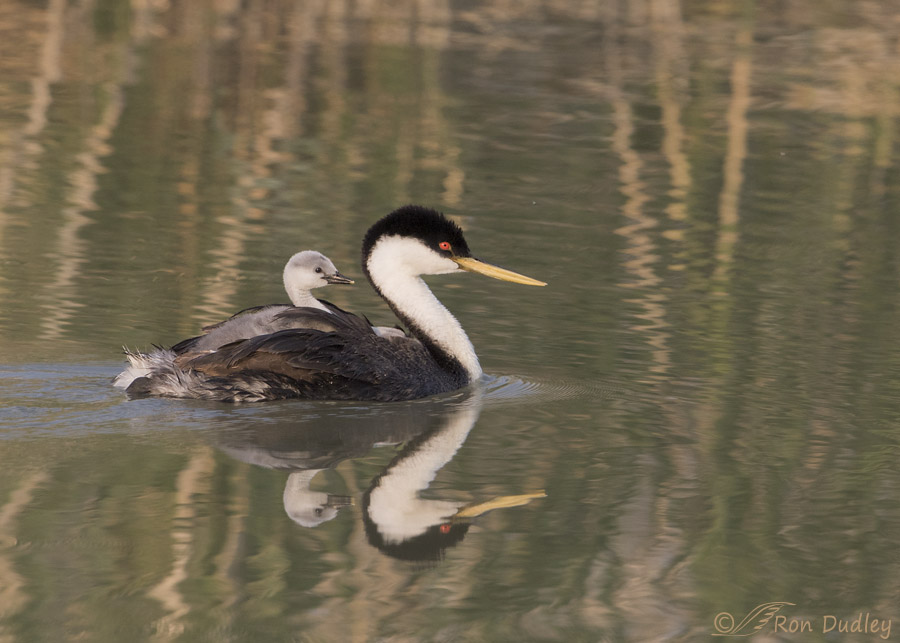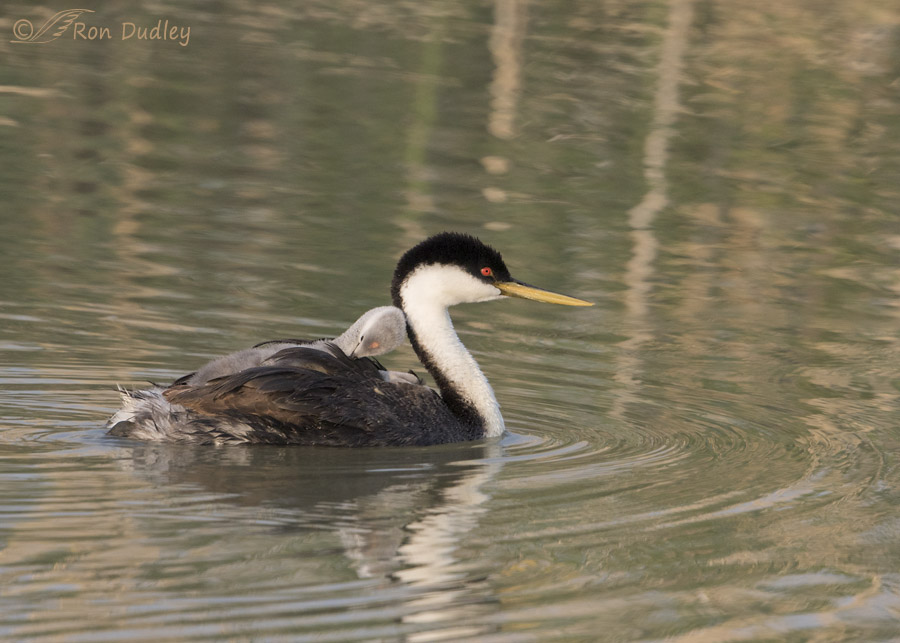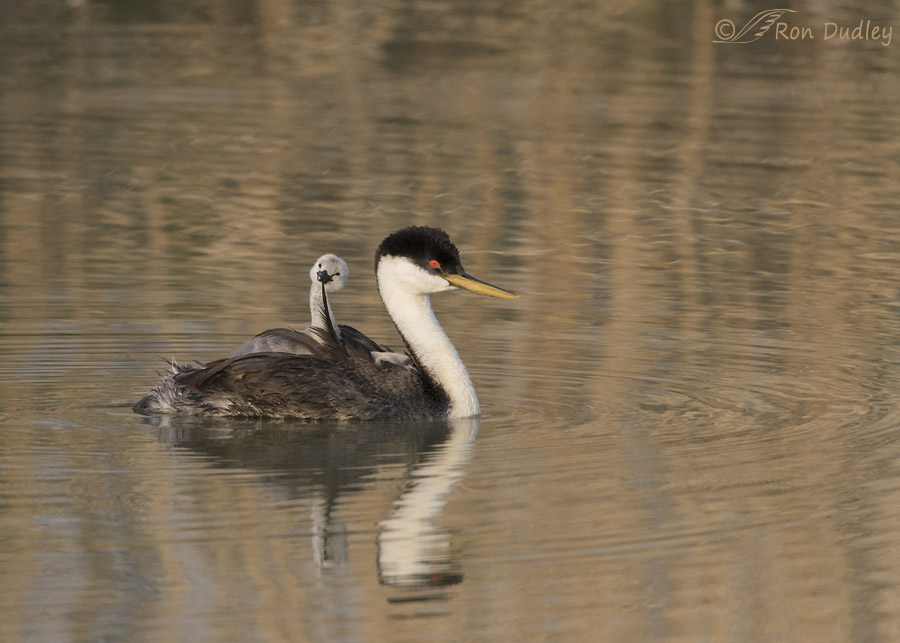I’m always surprised when I see Western Grebes with young chicks this late in the year but it does happen.

1/1600, f/6.3, ISO 640, Canon 7D Mark II, Canon EF500mm f/4L IS II USM +1.4 tc, not baited, set up or called in
Two days ago I photographed this one with a chick on its back at Bear River Migratory Bird Refuge. Western Grebes have an extended breeding season and some are even known to still be on eggs in mid-August and with chicks through the end of the month. I enjoyed finding these birds because this was the first time this season I’ve been able to photograph back-brooding grebes.

1/1600, f/6.3, ISO 640, Canon 7D Mark II, Canon EF500mm f/4L IS II USM +1.4 tc, not baited, set up or called in
Youngsters have a bare spot on their crown through their first several weeks after hatching. Typically that patch is straw yellow to salmon colored (as we see here) but in times of excitement, when begging for food or when they’re separated from their parents for example, it turns bright scarlet. I can’t help wondering if it’s just a coincidence that the color then matches the eyes of the adult…

1/2500, f/6.3, ISO 640, Canon 7D Mark II, Canon EF500mm f/4L IS II USM +1.4 tc, not baited, set up or called in
But this little guy was as calm as could be as it rode contentedly, slept occasionally and played with the feathers of its parent so the patch never did turn color that I noticed. I’ve seen it do so before and the color change can be dramatic.
Usually Western Grebes have more than one chick. This time I only noticed one in the field but in looking at these images I believe there may have been another one buried in the feathers between the wings directly behind the neck of the parent. If so it apparently slept the entire time I was there.
Ron


Loved all of the pics. What a cutie. How contented the little one is. Just enjoying his day.
Thank you, Jean.
I start my daily education in the most delightful way with your posts. Thank you.
Could this be a late hatching to replace one which was lost earlier in the season? Do the Grebes do that?
EC, If their nest is lost they will often renest but they typically only have one brood per season.
Thanks for the wonderful post. I have always wanted to see the little ones on the back of the parent, but have never been so fortunate.
I hope you have that opportunity one day, Jane.
That is one really cute baby. Thank you for starting my day with a smile. It is very uplifting to see photos like these.
Thanks, Susan. I’m glad you enjoyed the post.
Beautiful shots. A couple of days ago I was surprised to find a pair of Red Necked Grebes still feeding a chick on ones back while a second chick stayed in the water. Might be a response to the long warm summer we are having.
Could be, Alan, though I know that Western Grebes occasionally nest late like this even in “normal” summers. I don’t know much about Red-necked Grebes…
Does the parent feed the chick when it’s still hitching a ride…or after t’s been dumped into the water? Love the idea of a “leg ladder”…guess that’s what they (Grebes) mean by “giving a leg up”…( forget about horses…or walls!)…
Patty, While one parent serves as a “taxi” the other fishes and brings the meal to the family. Sometimes the fishing parent gives the fish directly to a chick, other times the fish is given to the “taxi” and that parent gives it to the chicks.
Both parents often pick up small down feathers floating on the water and give them to the chicks to eat. The feathers aid in digestion – something I’ve covered in previous posts.
What other birds “back brood”? I know loons do and I’ve seens swans do it…. And what happens to a hitch- hiking chick if the parent suddenly decides to fly? (Sorry to ask so many questions…your photos and comments always raise a flood of them)….I do the same thing to Jerry….just an unintentional pest…
When the chicks are young they’re fed while they’re on the back of a parent. Later, when they’re larger, they’re fed in the water.
Loons, grebes, coots and some ducks and geese carry babies on their backs.
Just enchanting–I especially appreciated the info about the “bald spot” and its change of color under stress–the behavioral notes you make are almost as wonderful as your
photographic work–something good almost every morning–that’s quite an accomplishment.
I’m delighted to know that you enjoy the “behavioral notes”, Kris. As you may know I’m a bit of a bird behavior freak so I’m sure there’ll be many more of them in the future.
Wonderful shots!!! The first is a classic, but the others are so much fun. Another very informative match up of photos and comments…always something new and interesting. Love it!!! (Keeps the wheels of this rusty old mind creaking along). Thanks, once again!!!….
Thanks, Patty. And I can assure you that there’s nothing rusty about your mind. It’s still shiny metal, greased and running smoothly.
Ron, thanks for another great nature lesson.
David
You’re very welcome, David.
This was really fun. I didn’t even see that second lump of gray until you mentioned it.
I didn’t see it at first either, Arwen – in the field or on my computer. These old eyes just fail me at times…
Boy, Ron – I’d love to go out with you on one of your trips into the wild with your trusty camera. What you capture on a regular basis is a joy to behold. These grebes are SO spetacular. My favorite is the little one pulling at the feather of his parent – so special!!
My trips to the refuge can be pretty boring at times, Jo Ann, but when “stuff” happens it can transform instantly. Birds are like that…
That lucky baby has the warmest, safest, most perfect way to be introduced into the world. Do you know if both sexes back brood? Thank you for giving me this glimpse of Grebe life!
Yes, both sexes back brood, Mikal. When one parent gets tired of that duty it raises up in the water and flaps its wings which dumps the chicks in the water. When that happens the youngsters usually crawl onto the back of the other parent.
And when the chicks are very small the parent often sticks one leg out behind to serve as a “ladder” for the chicks to crawl up on. Pretty neat!
I agree, great set and a good documentation of the approximate age of chicks still being carried by Mom. Maybe Mom likes having the chick preen her back!!
Thanks for sharing.
“Maybe Mom likes having the chick preen her back!!”
Dick, I suspect he/she appreciates that more than having it beg for food. These chicks seem to be perpetually hungry and their begging calls are incessant and (to me) irritating after a while – especially after they get a little older.
How adorable! A wonderful set of shots Ron. Thanks for sharing.
Charlotte
Thank you, Charlotte.